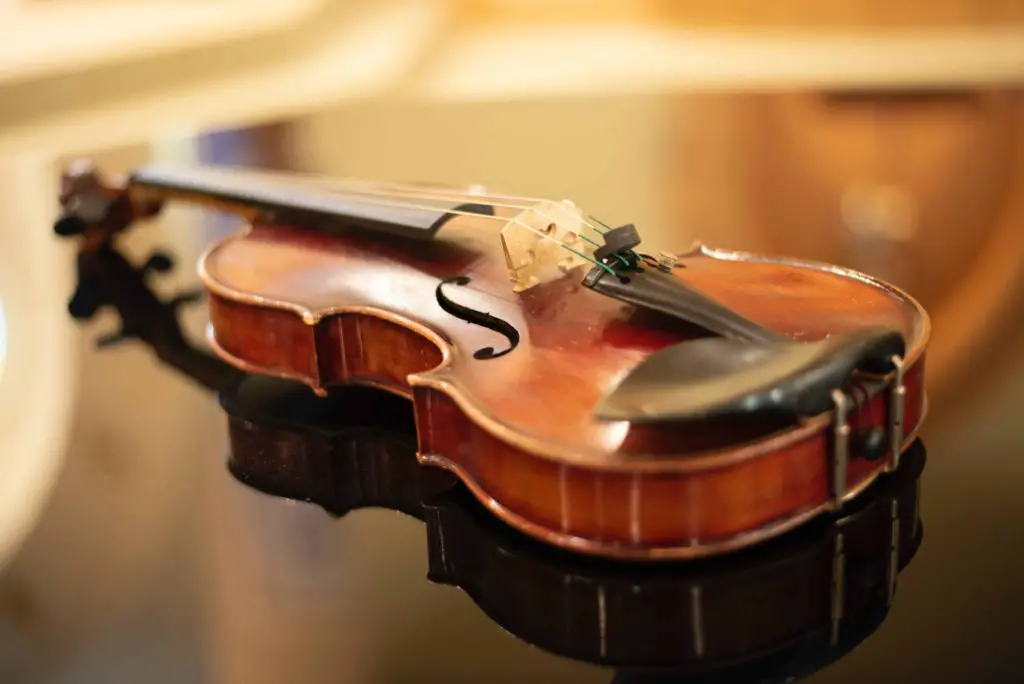Violin mutes are useful tools for violin players to use when they need to modify the sound of their instruments. Violin mutes are essentially a small device used to cover one or both of the violin’s holes in order to lower the violin’s volume.
Mutes are typically made from either metal, wood, or rubber. Violin mutes can be used for various reasons, but are commonly used in orchestras to make different sounds or effects. They can also be used to reduce playing volume during practice sessions.
This article will explore what violin mutes are, how they work and why we use them.

Table of Contents
How Do Violin Mutes Work
Violin mutes are designed to improve the violin’s tone by altering it in some way. There are a few different types of violin mutes, and each type changes the tone slightly differently. The most popular type is a rubber mute.
When you put a rubber mute on your violin, two things happen that change its sound:
1. The rubber mute dampens the sound waves.
2. The rubber material changes the vibration of the strings, which contributes to how it sounds.
Different types of violin mutes will produce different effects on your violin’s tone. So if you’re looking for a certain kind of tone, be sure to use that type of mute! Here are descriptions of some other styles of violin mutes.
The practice mute: This style of violin mute is made specifically for practicing so you can still hear yourself play while not disturbing anyone else’s peace and quiet. This kind of mute has a soft rubber surface, but instead of being placed on the bridge like most mutes, it covers the entire instrument from the neck to the bridge. Because it’s rubber, this mute is not as effective as violin mutes that are shaped differently.
The guitar mute: This style of violin mute is only used by a few people, so you probably won’t have to know how it works unless you plan to buy one for yourself! It’s similar to the way most violin mutes are used, but it fits over the strings easier since it’s smaller than most mutes. If you’re looking for a mute that will work just like an ordinary one but is also small enough to fit in your pocket, this is the one for you!
Why Are Violin Mutes Used
Violin mutes are an essential part of the violinist’s toolkit. They help to reduce the volume of sound produced by a violin and allow for better control over dynamics (i.e., soft vs. loud). Violinists use them for practicing or performing in situations where they need to play quietly, such as when other musicians are playing loudly alongside them; or when they need to be able to match different volumes with other instruments in an orchestra; or when they want to produce softer music than would otherwise be possible on their instrument.
Violinists also use mutes during performances that require quieter passages, such as some classical pieces written in Baroque style; or folk music played on acoustic instruments like mandolins or guitars; or jazz music with other stringed instruments, like cellos or double basses.
Differences Between The Various Types of Violin Mutes

The different types of violin mutes are designed to alter the sound of the instrument in various ways. The most common type is a mute that covers at least one of the four strings and alters its tone by muffling it. Violinists use this kind to produce a softer sound or play without disturbing others. It can also be used to create special effects like harmonics when playing with other instruments that don’t have frets on their fingerboard.
Mute-less violins have been invented for those who want more volume from their instrument but they’re not as versatile as traditional ones because they can only produce one timbre, so you either get a loud version or the soft version
There are two main kinds of violin mutes:
Mutes for individual strings: It’s a small rubber band that fits on just one of your violin strings. It dampens the tone and changes its pitch, but some players say it has a slightly metallic sound to it. The mute is held in place by wrapping it around the string above the bridge.
Mutes for all four strings (Claw): This type of mute covers every one of your strings with special dampening materials that prevent vibrations from being produced. The sound is similar to that of a muted trumpet and can be used in symphonic orchestras, chamber music groups, or pop ensembles where the strings need to blend with other instruments without overpowering them.
Other types of violin mutes:
- Mute for the E string only – It’s another rubber band that covers just one of your strings and it dampens its tone but doesn’t affect pitch or volume much. The mute is held in place by wrapping it around the E string above the bridge. It can be used to create a more mellow sound with less volume without completely muting the tone.
- Spoon mute or fingerboard muting, which is sometimes referred to as ‘the Claw’ because it looks like a claw grasping the fingerboard. Some players use this type of mute when they have an orchestra score with very high notes that are difficult to play without losing control.
What Shouldn’t You Use Violin Mutes For (if you want the audience to hear you)
The worst places for violin mutes are auditions and recitals that take place in front of people who have paid money to attend the event. People go to concerts expecting to hear everything that the musicians do, and an audience would get upset if the violinist came out and didn’t play anything.
Auditions are stressful enough without worrying about playing with a mute in front of your future employer! Generally speaking, it is not a good idea to practice with a violin mute, nor should you use one in a concert unless absolutely necessary.
How Much Does a Violin Mute Reduce Sound
A violin mute can reduce sound by up to 80%. This varies with the type and brand of the mute. Cheap violin mutes will only reduce the sound by about 40%, but a good mute may create a 20 dB difference.
A big change in volume, such as a 90 dB reduction, can be very disconcerting to the audience and that is to be avoided whenever possible. A significant change in tone quality should also be avoided when changing from an un-muted violin to a muted one.
When you use mutes, it’s often helpful to mute the lower strings more than the higher strings to balance out the sound.
Can You Practice Violin Silently
Yes, there are multiple ways you can practice the violin silently. Using a mute is one of the most widely used methods. The mute is applied to the bridge of the violin in order to dampen the sound of your instrument. The vibrations created by playing on your strings are dulled or silenced by this device, allowing you to practice in silence without disturbing others around you.
While violin mutes are great, they do not come without their inconveniences. To begin with, the placement of a mute on your violin may result in a muffled tone or an off-key sound. Violin mutes also have a tendency to fall off while you are playing, which can create all sorts of unpleasant sounds. Mutes also tend to dampen your strings less or more than you may prefer, so it is best to try a few different styles before committing one to regular use.
In addition to violin mutes, there are other silent practice options available, such as the electric violin and electronic violin mute. These instruments are specifically designed to mute the sound of your strings, making silent practice possible without the use of violin mutes. However, these items can be rather pricey and may not produce tones that accurately reflect what you play when not muted. If you would like to try out an electric violin or electronic violin mute, it is best to rent one before making a purchase.
Additionally, you could use a bow without rosin to prevent the strings from producing sound.
It is also possible to practice without the use of violin mutes by simply playing on an old, un-stringed instrument or one that has its strings tuned down very low. These methods can be inconvenient and will not help you with your intonation or bowing techniques, but they are effective in allowing silent practice.
However you choose to practice, it is important to remember that violin mutes are only meant as a means of silent practice. If you are playing with an orchestra or other ensemble, make sure to keep your mute off (unless the piece requires it). Muted violins do not blend very well with the rest of the group!
Do Violin Mutes Cause Damage to Violins
The most likely time for a mute to damage a violin is when it is being attached and removed. To prevent damage to the bridge, hold the bridge while installing and removing the mute. This will also keep the bridge from moving and impacting the tune of your violin.
The need for increased bow pressure that comes with the use of some violin mutes could cause damage to a violin’s strings. This is especially true with a heavier type of mute, such as a metal one that brings the acoustic volume of a violin down very low.
Mutes should be removed while practicing long tones, scales, and arpeggios.
Using a violin mute should not cause damage to the top surface of the violin. However,, take care not to scratch the top surface of the violin when removing a mute.
Most violin mutes are made of felt or rubber and will not damage your violin’s varnish. Also, many violinists prefer the feel of a properly fitted rubber mute to that of some metal mutes which can produce too much pressure on the top plate, causing it to ring harshly.
You can also damage your violin with the mute if you forget to remove it when you store your instrument in its case. The lid may accidentally close on mute and cause damage to the bridge.
Should Beginners Use Violin Mutes
Some teachers believe that violin mutes should be used from the beginner stage, but many violinists leave them off until they have mastered a good bow hold and intonation.
It’s best not to spend additional money on a violin mute before starting to learn the violin; instead, as a beginner, you should just use whatever your violin comes with.
Muting can begin when you can produce a full tone that isn’t too loud or scratchy. Once you’re able to produce clean notes, that’s an indication that it is time to start considering the purchase of a practice mute.
Conclusion
If you want to use a violin mute for practicing, make sure that it doesn’t interfere with your ability to do so. A violin mute does not work in all situations. If you’re playing at an audition or recital where people have paid money, keep the mute off unless absolutely necessary.
When you’re ready to buy a violin mute, be sure to get a good mute from a reputable manufacturer like D’Addario String Company Inc., Thomastik-Infeld GmbH & Co KG, or Pirastro USA Ltd. These companies offer high-quality products that will do their job without compromising tone production too much.
My goal with this post was to help you find the violin mute that will work best for you (available on Amazon). Whether it’s a question about how they work, what sound reduction they provide or anything else related to these accessories, I hope this post has helped answer some of your questions and given you more information on which one might be right for you.

